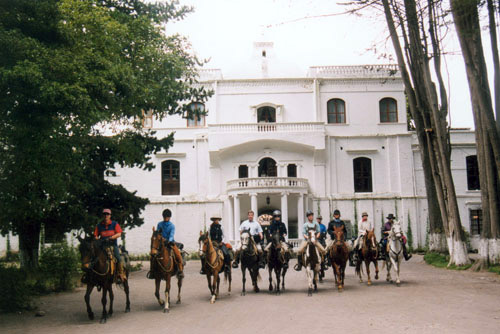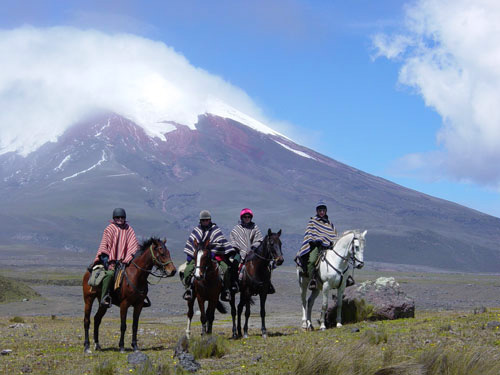Colonial Haciendas & Inca Trail
A ride into Ecuador's History
There can be few more exciting ways to discover a country than by horse. It was the dashing image of poncho-clad horsemen galloping through the pampas and up into the mountain ranges of the Andes that had me packing my bags and setting off for Ecuador on a week-long riding adventure. The six other guests, accompanied by three chagras (gauchos), were all desperate, like me, to escape pre-Christmas hysteria. We were led by the charming and impressive Sally Vergette, who, several years ago, fell in love with Ecuador and together with Hidden Trails set up a small but highly efficient operation that organises rides in Ecuador. Our trip would take us from hacienda to hacienda, riding through some of Ecuador’s most breathtaking landscapes.

On the first day, we spend only a few hours in the saddle, in an attempt to avoid stiff legs, in the foothills of Cayambe, Ecuador’s third-highest volcano. The saddles are old US cavalry stock that Sally has had recovered, sort of cross between a Western and an English saddle cushioned by layers of sheepskin. We stop in a forest to eat the picnic that we’ve carried in our saddlebags – palm hearts, cold chicken, an array of local cheeses, fresh mangoes – before heading off to the nearby Otavalo market. Famous for its alpaca rugs and elaborate knitwear, Otavalo is a sea of colour, from the brightly draped stands to the clothes of the Ecuadorian women, who wear the traditional embroidered white lace blouses along with tiers of gold bangles stacked up on their necks and arms. After bartering for our purchases, we return to the first hacienda on our trail, Hacienda Pinsaqui, where we are welcomed to Pedro Freile Guarderas and his eight-year-old son.
Built in 1780 and still owned and run by the same family, Pinsaqui, a former textile estate, exudes a wonderful sense of decaying splendour. By the log fire in the bar, we sample a variety of Ecuadorian liqueurs, including the potent aniseed-flavoured Norteno; Pedro entertains us with tales of his family’s past as we are serenaded by a band of local panpipe musicians. There is a photo of Pedro’s father beside a bar standing with his favorite horse. I am delighted by the eccentricity and also by the fact that Simón Bolívar, the famous South American liberator, slept in the bed in my room.
After a huge breakfast where, bizarrely, I run into Britain’s former minister for culture Chris Smith, we set off from the base of Cotocachi through the foothills of an extinct volcano, Mojanda. We canter through fields of maize – the stalks tower over us – and pass through tiny villages, where the children run after the horses. At one point, we interrupt a volleyball game in the middle of the road. My horse hesitates as I urge him to step over the strands of wool that are doubling for ground lines on the makeshift court. Sally warns us about ‘Ecuadorian tripwires’ inadvertently created by the tethered livestock on the roadsides.
The landscape quickly becomes more verdant. Galloping through a forest of eucalyptus trees, we are met by two spectacular sights; the first, a breathtaking view over Cayambe; the second, lunch, which two of Sally’s helpers have prepared and brought by car. Food has never tasted so good.

Casa Mojanda is our next stop, built just five years ago by its owners, Diego and Betti. This fascinating couple grows almost 70 percent of their food in an organic garden. Those who still have energy to burn set off on a hike to a nearby waterfall. Others, myself included, make their way down to a hot tub at the garden, where Llamas start curiously at us as we lover out aching limbs into the deliciously hot water.
The next day, we climb some 1,200 feet, to be rewarded with some fantastic views of San Pablo Lake. Then there’s a short ride to Hacienda Cusin, which is to be our home for the next two nights. Cusin is a wonderfully comfortable hacienda, with a vast cobbled courtyard, and cheery blue and white paintwork. None of us can quite believe it’s Christmas Eve. So far, the only seasonal concessions have been the tiny sprays of tinsel on the horses’ bridles, but that evening we are treated to a special Christmas Eve dinner in a frescoed refectory in the monastery, and carols performed by a local choir. Then it’s midnight mass in the modest-looking village church, which is a surprising mass of gilt and marble inside. We return to find the gates of the hacienda locked; the night porter is snoring blissfully. One of my co-riders shimmies up the door, another undoes the latch and the ‘vicious’ guard dog, dressed in an elf costume, wags his tail in welcome. Roaring fires have been lit in the bedrooms and I nod off to sleep watching the flames’ shadows dance across the room.
Christmas Day dawns bright and sunny, and we set off on a simple loop ride that will bring us back to the hacienda that evening. Village children sporting ‘Papa Noël’ hats greet us, shouting ‘Feliz Navidad’. Champagne and smoked salmon appear, as if by magic, in the middle of a field and we trot back to Cusin, tipsily working our way through some carols. The next day’s terrain suddenly looks more Scottish Highlands than Ecuador. We climb 4,000 feet through lush grasslands and rocky peaks, with the temperature alternating between boiling and freezing. Cattle and even small herds of wild horses graze. Deep ditches separate the estates from each other – a throwback to the days when fighting bulls were used to guard the land. We even canter through the clouds. It’s a taxing day’s riding, which makes Hacienda Guachula an all the more welcome sight.
This is one of the country’s oldest haciendas – in the 1930s, all of Ecuador’s more important families were said to have met here and divided the country between them. The current owner, the mayor of Cayambe, tells us ghost stories as he tucks into the local specialty; roast guinea pig.
The next day, we swap our horses for mounts more acclimatized to high altitude. It takes balance and lots of nerve to manoeuvre across the more treacherous paths, and it is a rather muddy-looking collection of horse and riders that saunter down the incredibly grand tree-lined drive that leads to the elegant 16th-century La Cienega, which is still owned by descendants of Simón Bolívar.
The final leg of the trip sees us cantering along dirt roads to the base of the snow-capped volcano in the Cotopaxi National Park. The plains are covered with a mossy, lichen-like plant and grass; it is perfect for long, satisfying gallops, although you do have to dodge the boulders – remnants of Cotopaxi’s last eruption. We race along the plateau, marveling at the huge dormant giant that looms 20,000 feet above us, the afternoon sun hitting its snowy slopes and lighting up the sky.
It doesn’t seem as if life can get any better, but it can and it does. The sweeping tree-lined drive only hints at thee splendour that is to come at Hacienda Chillo-Jijón, our final resting place. Our hosts, Jacinto and his girlfriend Marianna, lead us into the drawing room for fresh juice, as two manservants in whitecoats and gloves whisk our luggage away. Vast oil painting adorn every inch of wall space, and chandeliers ……………………………….
highlights
Galloping through the foothills of Cotopaxi, dodging volcanic rocks, the wind in my hair, poncho flying behind me.
route
The special ‘Christmas tour’ started in the foothills of the Cayambe, east of Quito, and finished in Cotopaxi National Park
accommodation
Some of Ecuador’s most stunning and luxurious haciendas
you ride with
Hidden Trails, their partner Sally Vergette, and their trusty team of chagras
For reservations and inquiries, contact Hidden Trails 1-888-9-TRAILS
or visit the webpage for more information at:
http://hiddentrails.com/tour/ecuador_colonial_haciendas.aspx